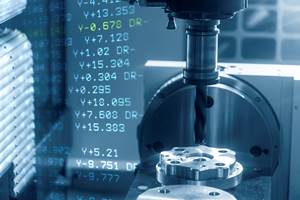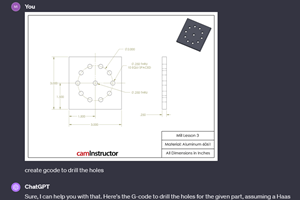Mold Maker Raises Productivity With Software
George Kasper, president of Innovative Mold, incorporated the company in 1989 with his brother David. The Washington, Michigan, firm began by making molds for the plastics industry.
Share





George Kasper, president of Innovative Mold, incorporated the company in 1989 with his brother David. The Washington, Michigan, firm began by making molds for the plastics industry. It now employs 26 people and produces 90 percent of its molds for the automotive industry for presses between 50 and 500 tons. Innovative Mold manufactures single-shot molds and two-shot rotational molds, producing interior parts, structural components and sound damping items.
“The appearance of many of the interior parts is critical,” Mr. Kasper says. “For example, a radio bezel may require two different resins injected to produce the required quality and appearance. We can offer rotational molds or pick-and-place robot transfer solutions to achieve the desired results in demanding applications such as this one.”
Innovative Mold installed its first CNC machinery in 1996. Today, its Toshiba and Cincinnati molding machines provide a means by which to conduct trial runs. The company manufactures prototype tooling in aluminum or steel depending upon the customer’s individual requirements.
Over the years, mold complexity increased, while machine tools became more sophisticated. The company acknowledged that its existing CAM package had some shortcomings, especially when dealing with P20 steel.
When Innovative Mold initially considered WorkNC from Sescoi USA, Inc. (Southfield, Michigan), it felt that it could not justify the cost. However, a successful trial run conducted by the company’s engineers persuaded George Kasper that the software would be a good fit for his business.
“WorkNC spends more of its time actually cutting, which has resulted in a productivity increase of between 25 and 50 percent through more efficient tool paths,” Mr. Kasper explains.
“Programming is nearly three times quicker with WorkNC when compared to our previous software package,” adds Quinn Sova, programmer at Innovative Mold.
CAD data is passed from the company’s design systems to WorkNC, which is dedicated to the preparation of CNC code.
“The cycles we use most frequently in WorkNC are high-torque roughing, high- torque reroughing, Z-leveling, Z-level remachining, planar finishing, optimized Z-level finishing, contour remachining, and tangent-to-curve and on-curve engraving, Mr. Sova says. “This gives us the flexibility to easily complete the most complex work.”
Because of the program’s reliability and capability to generate smooth tool paths, Innovative Mold says that it can use spindle speeds as fast as 28,000 rpm and feed rates between 0.04 ipm and 250 ipm, as well as cutters with diameters as small as 0.012 inches on titanium workpieces. A major contributor to success has been the re-machining function, which Innovative Mold uses extensively. After each machining operation, WorkNC can update the stock material model so that it knows exactly where excess material remains. Armed with this information, the software ensures that the tool is continually engaged with the job for the subsequent operation. The manufacturer says that this maximizes productivity and minimizes shock loading, which could lead to tool breakage.
“The roughing cycles have saved us a considerable amount of time,” Mr. Sova explains. “The capability of WorkNC to machine more of the mold directly has contributed to a reduction in the number of electrodes that we have to make as well.”
WorkNC is a valuable element in the parallel processes that Innovative Mold operates. When the customer orders the mold, the company raises an order for the steel during the design evaluation phase. Similarly, mold manufacturing begins as the design is being finalized, enabling it to continuously build as much of the tool as possible in parallel with other tasks. According to the company, this reduces lead times.
“WorkNC has cut programming and machining times,” Mr. Kasper says. “We have reduced delivery on aluminum prototype tools to 2 weeks and production tools to 8 weeks.”
“WorkNC is an integral part of our production process and an efficient means of programming cutter paths,” he says.
Related Content
How this Job Shop Grew Capacity Without Expanding Footprint
This shop relies on digital solutions to grow their manufacturing business. With this approach, W.A. Pfeiffer has achieved seamless end-to-end connectivity, shorter lead times and increased throughput.
Read MoreTips for Designing CNC Programs That Help Operators
The way a G-code program is formatted directly affects the productivity of the CNC people who use them. Design CNC programs that make CNC setup people and operators’ jobs easier.
Read MoreCan ChatGPT Create Usable G-Code Programs?
Since its debut in late 2022, ChatGPT has been used in many situations, from writing stories to writing code, including G-code. But is it useful to shops? We asked a CAM expert for his thoughts.
Read MoreOrthopedic Event Discusses Manufacturing Strategies
At the seminar, representatives from multiple companies discussed strategies for making orthopedic devices accurately and efficiently.
Read MoreRead Next
Machine Shop MBA
Making Chips and Modern Machine Shop are teaming up for a new podcast series called Machine Shop MBA—designed to help manufacturers measure their success against the industry’s best. Through the lens of the Top Shops benchmarking program, the series explores the KPIs that set high-performing shops apart, from machine utilization and first-pass yield to employee engagement and revenue per employee.
Read MoreAMRs Are Moving Into Manufacturing: 4 Considerations for Implementation
AMRs can provide a flexible, easy-to-use automation platform so long as manufacturers choose a suitable task and prepare their facilities.
Read More





















